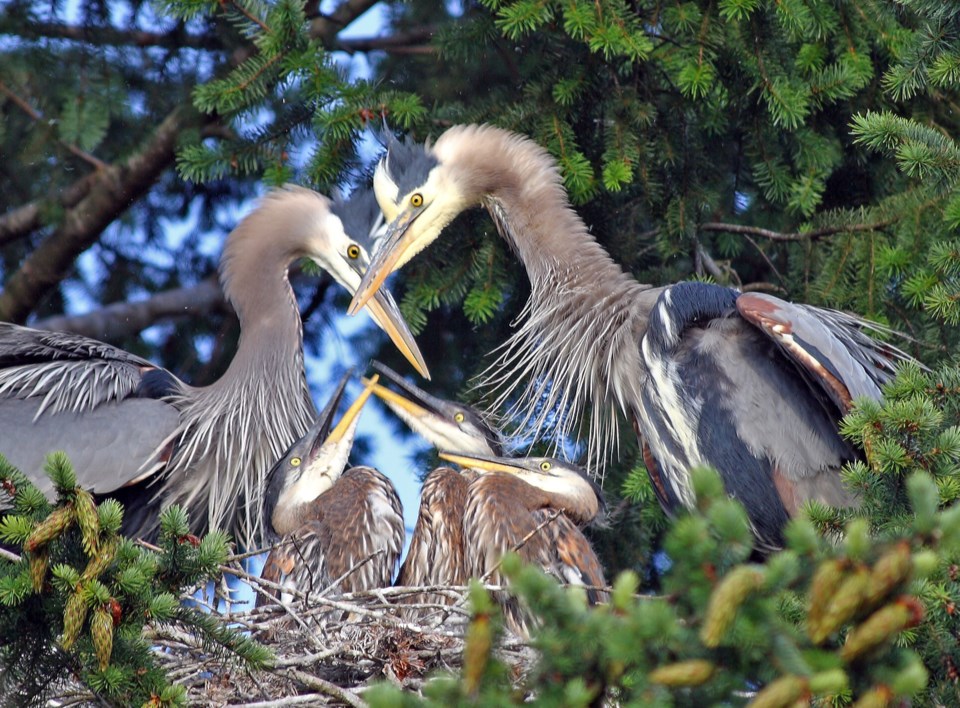Last Wednesday, Pam Dicer saw two pairs, and a single heron, perched in the trees across the street from the Snug Coffee House.
“That’s the more than I’ve ever seen before at one time,” says Dicer. “There is a very small window of time, before all the leaves are out in the trees, when you can actually get a good view of them.”
Not everyone shares Dicer’s enthusiasm for the birds and their presence in lower Snug Cove.
“They spend most of the year walking on our dock,” says Rondy Dike with the Union Steamship Marina. “And they’re used as a way to stop any form of development.”
Municipal Councillor Tim Rhodes says he has heard numerous complaints from residents who say there are too many herons, and they make a mess. He also says that their presence and the regulations concerning them during their nesting season significantly interfere with development activities in Snug Cove.
“Nothing can happen within 60 metres of a nest,” says Rhodes. “I feel there has to be some kind of middle ground when it comes to protecting them. I would like to see if the Province would consent to have the nests moved.”
Rhodes points to the corner of Cardena and Government Roads as an area that should be changed, but isn’t because of the herons.
“It can be absolutely terrifying down there, people really seem to forget all the rules of the road,” he says. “Something needs to be done to make it safer, but because of the herons it’s really difficult.”
Pacific Great Blue Herons (Ardea herodias fannini) have been nesting on Bowen for 17 consecutive years. In 2002, the Municipality adopted a policy to protect the birds’ nesting sites. This policy restricts the use of heavy equipment between February 1 and July 31 within 150 metres of a nest; loud, irregular noise such as hammering within 100 metres between February 1 and March 15; and tree-felling within 50 metres of a heron nest between February 1 and July 31.
Bowen Heron Watch has been recording the success of local herons in fledging their young since 2005. In their recorded observations, the loss of eggs or death of young herons are often attributed to human disturbances. For example:
- In 2013: two to three chicks fledged and were seen together with adult herons at the lagoon in late summer. Which nest the youngsters came from is unknown. Herons were seen mating at the Crippen/Library nests mid-April. The following week, noisy municipal road repairs were conducted adjacent to the nests. The herons flushed from the nests during the cutting and compaction of the pavement, whereupon an eagle spent time in the nests presumably eating the eggs.
- 2012: No chicks hatched from two nesting attempts in three nests at the Crippen/Old General Store site and an established nest at Galbraith Bay. Challenges included eagles and human disturbance, including a new path to the Crippen/Library nests.
Unlike other kinds of herons, Pacific Great Blue Herons do not migrate, as a result, they do not breed with other heron groups and have in effect become their own sub species. Ross Vennesland, a local ecologist who came to Bowen this past weekend to talk about the herons, says their population is estimated to be around five thousand, and has been declining over the past 20 years. He says that based on his observations, eagles are the biggest threat to herons, but he sees human disturbance and eagles as a joint pressure.
“They habituate to us, for some reason,” says Vennesland. “And they habituate to noise, but anything sudden and new will disturb them.”
Vennesland brings up the example of Stanley Park as another location where herons have chosen to nest in close proximity to humans, causing annoyance.
“There are 200 nests right by the tennis courts, and there the ground gets coated in white guano,” says Vennesland. “They’re also noisy. I think living beside a heron colony probably the worst sound would be the constant begging of the chicks.”
While everyday noises associated with being in an urban centre do not seem to disturb the herons, sudden ones, such as the stream of Sun Run participants who passed by their colony some 10 years ago, caused visible upset. Consequently, organizers of the Sun Run changed the route.
Vennesland says that we don’t know exactly why herons choose to nest in close proximity to humans, but that it is unreasonable to expect them to simply move and find a site more appropriate to them.
“The risk is if they abandon that site, they may not have another site that they prefer nearby so they may leave the area. This is probably what has been happening in Howe Sound and the Sunshine Coast over the past couple of decades. There used to be nearly 100 heron pairs nesting on the Sunshine Coast (including Howe Sound). Now we know of far fewer than that (maybe 20 nesting pairs in a good year). We don’t know how much our actions have contributed to this decline, but one thing is clear - if residents want herons to continue to reside near their communities, this trend needs to be reversed and disturbing their colonies or developing lands they nest on will not help in that regard.”



